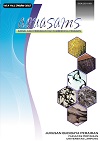ARTIFICIAL SUBSTRATES INCREASED SURVIVAL AND GROWTH OF HYBRID CATFISH (Clarias gariepinus >< C. macrocephalus)
Abstract
Artificial substrates on fish cultured applied to distinguish benefit on growth dan survival of hybrid catfish (Clarias gariepinus >< C. macrocephalus). Catfish has been cultured in intensive method and limited pond bottom. This study used completely random design with treatments consists of normal pond bottom; 1.5 folds; 2 folds and 2.5 folds of pond bottom. Results showed artificial substrates 1.5 dan 2 folds receive abundant fish for rest compare to normal pond bottom (P>0.05). Applied 2 folds of artificial subsrates showed better growth parameters (body weight and total length) of hybrid catfish compared to other treatment (P<0.05). Population and survival of hybrid catfish on 1.5 folds; 2 folds and 2.5 folds of artificial substrates significanlt different compared to normal pond bottom (P<0.05). Biomass of hybrid catfish has maximum gain while used 1.5 folds and 2 folds of artificial substrates (P<0.05). This study prove that artificial pond bottom benefit to aquaculture in term use of energy for growth effectively.

.png)










